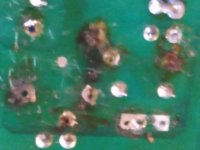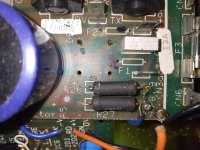If you have a fluke 175, ac volts is the first position from off; dc is the second. (AC is usually a sine wave, DC a dotted line and a solid line.)
PM me ill gladly help you with a curriculum of study to help you along, and answer questions.
your in new territory and familiarity with what your doing is paramount to getting a result and keeping you safe! if unsure or unclear please ask, i don't know what you know and am maybe not providing the right guidance for you?
your in new territory and familiarity with what your doing is paramount to getting a result and keeping you safe! if unsure or unclear please ask, i don't know what you know and am maybe not providing the right guidance for you?
I figured it out. THE bulb was bad. no flow, no work. So the readings I got are close to what you said. Now the Volts ac starts off in auto mode which gave on Bl/yellow #1=31.25 v. Bl/yellow #2= 31.24 both yellows=62.40
Now when I switch to manual mode it starts in .00, next setting .0, next setting 00. You follow? From hundredths to tenths to whole numbers. So when I get the whole numbers it was yellow #1=32, yellow #2=32, both=63
Close, but is it cigar worthy?
Now du I do the same test with the 100 wt bulb.
Oh and the bulb was dimly lit and consistent.
Now when I switch to manual mode it starts in .00, next setting .0, next setting 00. You follow? From hundredths to tenths to whole numbers. So when I get the whole numbers it was yellow #1=32, yellow #2=32, both=63
Close, but is it cigar worthy?
Now du I do the same test with the 100 wt bulb.
Oh and the bulb was dimly lit and consistent.
Last edited:
It’s normal for multimeters to count with nothing attached. I believe they’re picking up RF fluctuations in the wire leads. That itself doesn’t mean something is wrong with your meter.
Thank you. I had started the return process(and found another for $60 cheaper) I didn't think it could measure voltage out of thin air, but isn't that what Tesla was on about? I think I'll just cancel the return.
And just how does one check a meter for accuracy? I know they sell certified units for more money.
Last edited:
PM me ill gladly help you with a curriculum of study to help you along, and answer questions.
your in new territory and familiarity with what your doing is paramount to getting a result and keeping you safe! if unsure or unclear please ask, i don't know what you know and am maybe not providing the right guidance for you?
I think you are doing a good job by giving just what is needed and that makes me look up things that I'm not sure about. Then if I still don't get it, I can ask.
Last edited:
well you have a working transformer, that's good so we can move on to fixing the remainder of the supply.( so have a cigar and a shot of scotch!)
although not necessary you can do the test with the 100 watt lamp, the thing to note is that there will be less of a glow to the filament, likely none, that goes to the fact that the current limit is higher with the 100w bulb.
i wouldn't be too concerned about your meter's accuracy it is a Fluke after all, calibrating/ testing a meter requires lab grade standards.
although not necessary you can do the test with the 100 watt lamp, the thing to note is that there will be less of a glow to the filament, likely none, that goes to the fact that the current limit is higher with the 100w bulb.
i wouldn't be too concerned about your meter's accuracy it is a Fluke after all, calibrating/ testing a meter requires lab grade standards.
Last edited:
there's two ways to go, finish rebuilding the power supply or test the output stage transistors so which would you like to have a go at?
Well how about we just follow the signal path for the power so would that bring me around to the bridge rectifier in the Pico fuses?
I just realized signal passes the wrong term I guess the power power path. Going from the signal pass would be starting from the preamp side right and then ending up at the transformer now let's just follow the power path
I'll take some closer pictures of the boil on the board so you can make an assessment on the condition of it see if it's going to be usable I'll post those in a minute
p-
Attachments
Last edited:
Machine out the damaged portion
Or make a new board, if possible get another from somewhere.
It is burnt, will gradually disintegrate.
Or make a new board, if possible get another from somewhere.
It is burnt, will gradually disintegrate.
any chance of a better pic of the board? the foil is damaged but i don't think the PCB is chard which would matter more if tubes and higher voltage where at play, the foil damage can be circumvented with appropriate wire jumpers.
it is a high res picture, it just wont upload with that clarity. If I could email it direct you would see clearly. Unless you want a picture showing more of the board. I couldn't help burning the board when I removed those fuses the previous owner gad installed. It was like 10 gauge wire so it took a lot of heat.
wire is like a wick for heat so when removing things/desoldering it's sometimes best to cut things away then clean up the small bits....
well that depends on what you feel you can reasonably accomplish next, installing the new fuses and bridge rectifier is what i would do. and as the foil damage is going to complicate the matter a careful approach and some creative lead bending should make for a successful repair.
when i say creative lead bending i mean creating a bump in the leads so that the bridge doesn't rest against the PCB and leaving enough length so that on the bottom side there's enough to bend over creating a retainer so that it's physically held in place and allow for wire jumpers to connect to the rest of the circuit. i'll try to work up a drawn example of what i mean.
when i say creative lead bending i mean creating a bump in the leads so that the bridge doesn't rest against the PCB and leaving enough length so that on the bottom side there's enough to bend over creating a retainer so that it's physically held in place and allow for wire jumpers to connect to the rest of the circuit. i'll try to work up a drawn example of what i mean.
- Home
- Live Sound
- Instruments and Amps
- Marshall 3315 missing parts???

